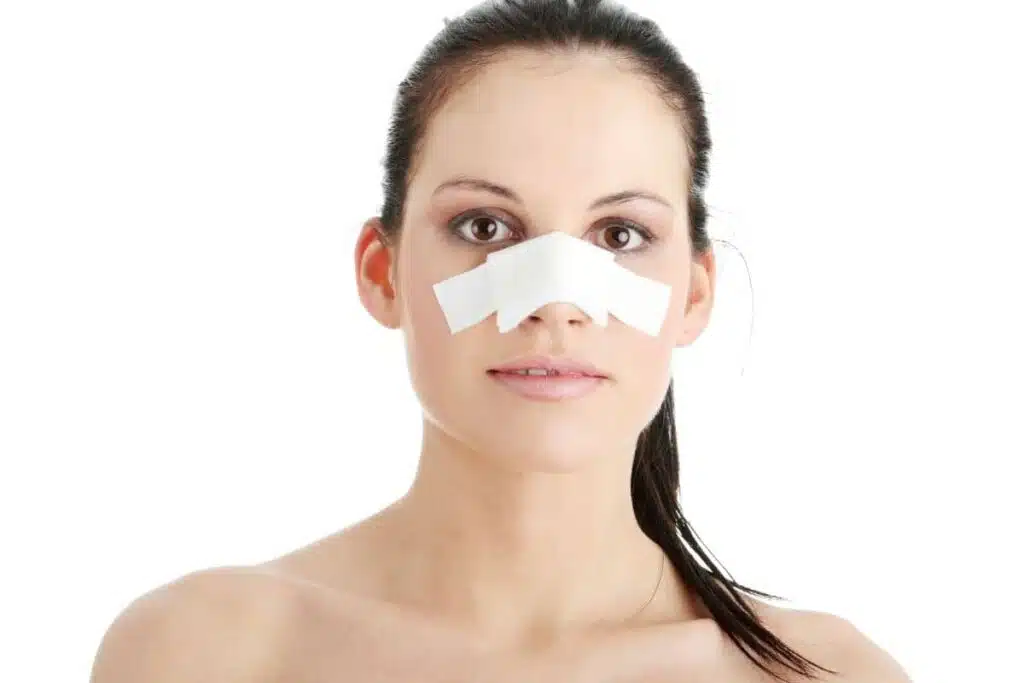If you are considering a nose job, one of the biggest questions you may have is how the healing rhinoplasty swelling stages will progress. Swelling is part of the healing process after rhinoplasty surgery, but understanding the timeline—and what is normal at each step—can bring you peace of mind. As a board-certified facial plastic surgeon specializing in rhinoplasty and revision rhinoplasty, Dr. Kirk Lozada has extensive expertise in guiding rhinoplasty patients through each swelling stage, ensuring the best possible outcomes. Below, we will cover what to expect and how to handle your recovery so you can appreciate your nose’s new shape sooner.

5 Simple Insights About Your Rhinoplasty Recovery
- Swelling is a normal and expected part of the nose job healing process.
- Most noticeable swelling subsides within the first few weeks, but some residual swelling can last after rhinoplasty for up to a year or more.
- Every rhinoplasty timeline is unique and can be influenced by factors like skin thickness, cartilage repositioning, and the extent of nasal reconstruction.
- Consistent aftercare instructions—such as keeping your head elevated and avoiding strenuous activities—can help prevent complications and speed up recovery.
- Consulting an experienced surgeon like Dr. Kirk Lozada is the best way to ensure a smooth healing timeline and beautiful final results.
Swelling After Rhinoplasty Timeline
Rhinoplasty swelling stages typically unfold over several months, and the process can differ from person to person. The following timeline offers a general guide. As you read, remember that individual experiences will vary based on factors like facial structure, skin thickness, and whether you had a revision surgery or a more extensive nasal reconstruction.
Immediate Post-Operative Phase
Right after your rhinoplasty surgery, the first week of recovery begins. During the first 48 hours, your face and cheeks may feel puffy, and you will likely notice bruising under your eyes. This phase is when swelling is at its most intense because of fluid buildup. Your nose will be protected by nasal dressings or splints, and you may have difficulty breathing through your nose due to inflammation or residual fluid. Keeping your head elevated, applying cold compresses, and following Dr. Lozada’s detailed aftercare instructions can help reduce swelling and bruising.
0-48 hours
Acute Swelling Stage
By the end of the first week, you will likely return to see your plastic surgeon for a follow-up. During this acute swelling stage, much of the initial puffiness will start to subside, offering a dramatic reduction in bruising and fluid retention. While you still may see noticeable swelling in the nasal tip and around the septum, many rhinoplasty patients are pleasantly surprised by how much of the bruising fades. Some uneven swelling might persist, and the nose can appear asymmetrical in certain areas. However, this is normal as your body is gradually adjusting to its new shape and repositioned cartilage.
1-2 weeks
Subacute Swelling Stage
The second week to the fourth week after surgery often brings further improvement in swelling and bruising. You may still have some noticeable swelling around the bridge and nasal tip, but it will typically be less pronounced than before. Though the nose may feel tender, you can usually resume many of your normal daily activities—except for strenuous activities, which should still be avoided to prevent complications. This subacute stage is a vital part of the healing timeline as the tissues continue to settle, the fluid buildup reduces, and you get a clearer glimpse of the eventual shape.
2- 4 weeks
Intermediate Stage
By the one-month mark, you will likely see a more refined nose. Significant swelling should be greatly diminished, and most residual swelling will be subtle rather than dramatic. Some patients might experience a little puffiness that comes and goes, particularly in the evenings or after physical activities. The nasal tip is often the last area to show its final definition because the skin in this region can be thicker and more prone to swelling. It is also at this stage that many begin to appreciate the functional and cosmetic improvements, such as easier breathing and an improved facial balance.
1- 3 months
Long-Term Refinement Stage
Between three and twelve months after the procedure, the healing process will continue, but changes become more subtle and gradual. Cartilage and skin adapt further to their new configuration, and any uneven swelling typically evens out. Though you may still notice minor fluctuations in swelling due to fluid retention (for example, if you consume salty foods or engage in strenuous exercise), the overall nasal shape continues to refine. Revision rhinoplasty or nasal reconstruction patients may experience a slightly longer timeline if more extensive work was done on the nose or septum.
3- 12 months
Final Stages
Last is the final, most refined stage, typically between twelve and eighteen months post-surgery. At this point, you will see the nose in its near-complete form. While subtle changes can still occur, they tend to be minimal. The tip, bridge, and overall structure should closely reflect your surgeon’s intended outcome. If you remain patient and follow your surgeon’s guidance, the final results will be worth the wait, providing a harmonious balance to your face.
12 – 18 months
Before and After Rhinoplasty Photos
* All patients are unique and individual results may vary.
Factors Affecting How Long Recovery and Swelling Last After Rhinoplasty
Though many rhinoplasty patients follow a similar month-by-month timeline, several factors can influence how quickly (or slowly) your swelling resolves. This healing process can vary based on:
- Use of Prescription Medications: Certain medications, such as blood thinners or anti-inflammatory drugs, can either exacerbate or mitigate swelling.
- Skin Thickness: Thicker skin tends to retain more fluid, which can cause prolonged swelling and puffiness.
- Extent of Surgery: Procedures involving bulbous nose rhinoplasty techniques or more complex revisions often require more tissue manipulation, leading to increased fluid buildup.
- Individual Healing Response: Every body reacts differently to inflammation. Genetics and overall health can influence the degree of swelling and bruising.
- Compliance with Aftercare: Properly following instructions—like sleeping with your head elevated and avoiding strenuous activities—helps prevent complications and speeds up the healing timeline.
Managing Swelling Post-Nasal Surgery
Although swelling is inevitable, there are basic ways to reduce its impact and ensure a smoother rhinoplasty recovery:
- Elevate Your Head: Keeping your head propped up, even during sleep, helps reduce fluid retention and puffiness.
- Apply Cold Compresses: Gently applying a cold pack around the cheeks (but not directly on the nose) during the first few days can help ease inflammation.
- Follow a Healthy Lifestyle: Stay hydrated, limit sodium intake, and avoid smoking or alcohol to reduce residual swelling and support overall healing.
- Avoid Strenuous Activities: Exercise raises blood pressure, which can worsen swelling and bruising in the early stages.
- Protect Your Nose: Steer clear of any impact to your nose, and consult your surgeon before wearing glasses or makeup in the initial weeks after surgery.
expertise and precision for stunning rhinoplasty results
Visit Dr. Lozada in Philadelphia for a consultation and take the first step towards a successful recovery and beautiful outcomes.

Why Choose Dr. Kirk Lozada?
Selecting the right facial plastic surgeon is crucial for achieving a beautiful result and minimizing complications. Dr. Kirk Lozada is a board-certified, Philadelphia-based specialist with years of experience in rhinoplasty, revision surgery, nasal reconstruction, and other facial cosmetic procedures. He understands the nuances of repositioned cartilage and skin thickness to optimize your nose’s final shape. With a reputation for meticulous surgical technique and compassionate patient care, Dr. Lozada is dedicated to helping you navigate each step of the healing process comfortably. His practice also offers state-of-the-art technology, convenient scheduling, and personalized treatment plans to ensure every patient receives the best possible outcome.
Recognizing Signs of Abnormal Swelling

While some uneven swelling or puffiness is normal, keep an eye out for potential warning signs that could indicate a problem. Persistent or worsening swelling beyond the second week, especially if paired with severe discomfort, redness, or difficulty breathing, may signal complications. If you notice any of these signs, contact your plastic surgeon immediately for an evaluation. Addressing issues early on can prevent more serious problems and help ensure you remain on track for optimal final results.
Consult with an Expert Nose Surgeon
Rhinoplasty, whether it’s your first procedure or a revision rhinoplasty, can enhance both the function and appearance of your nose. Understanding rhinoplasty swelling stages, as well as the broader healing timeline, is key to maintaining realistic expectations and navigating each phase with confidence. Dr. Kirk Lozada and his team are here to guide you through every step—from the initial consultation to long-term follow-up, ensuring that you get the best possible care for your nose and face.
Ready to take the next step? Contact Dr. Lozada today to schedule your consultation. Our practice is committed to providing personalized treatment plans and the highest level of patient care. Don’t wait—secure your appointment and begin your journey toward a healthier, more refined nose.

